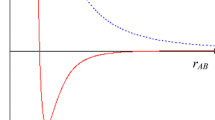Abstract
The incompatibility within the context of modeling cannot be established simpliciter. The fact that modeling is understood as an activity whose representational power can only be partially established, may minimize the supposed existence of incompatible models. Indeed, it is argued from perspectivism that incompatibility can be dissolved, meaning that it becomes trivial or simply false due to the inherently pragmatic and partial nature of the act of representation and modeling. From this perspective, incompatibility can only be a consequence of a misunderstanding of the very nature of modeling and representation In this sense, in order to tackle this strategy at its root from perspectivism, we will first need to outline the maximal perspectivism thesis, attempting to identify the possible escape routes that perspectivism could find in order to explain incompatibility as an illusory incompatibility. Then, we will analyze Valence Bond Model and Molecular Model of covalent bonds, and we will conclude that the dissuasive strategies used to minimize and/or disregard incompatibility prove to be fruitless.
Similar content being viewed by others
Notes
Surely, this seems to be almost a political and philosophical cleavage – based on community rules of play, and this could imply that a scientific community can change. What is clear is that the ties that identify a scientific community depend on these aspects. For the arguments presented in this work, what is relevant is to recognize that there is no single way to configure a scientific community.
We thank the editor for pointing out that the topic of this paper may have an argumentative confluence with the article in this volume “Why do prima facie intuitive theories work in organic chemistry” written by Hirofumi Ochiai.
References
Bailer-Jones, D.M.: When scientific models represent. Int. Stud. Philos. Sci. 17(1), 59–74 (2003)
da Costa, N., French, S.: Models, theories, and structures: thirty years on. Philos. Sci. 67, 116–127 (2000)
Chakravartty, A.: Perspectivism, inconsistent models, and contrastive explanation. Stud. Hist. Philos. Sci. 41, 405–412 (2010)
Frigg, R.: Models and Theories. Routledge, New York (2022)
Frisch, M.: Models and scientific representation or: who is afraid of inconsistency? Synthese 191, 3027–3040 (2014)
Gavroglu, K. y Simoes, A. The Americans, the Germans, and the beginnings of quantum chemistry: The confluence of diverging traditions, Historical Stud Phys. Biol. Sci. 25 (1), 47–110 (2012a)
Gavroglu, K.y Simoes, A.: Neither Physics Nor Chemistry. The MIT Press, Boston (2012b)
Giere, R.: Scientific Perspectivism. University of Chicago Press, Chicago (2006a)
Giere, R.: Perspectival pluralism, In: Waters C.K. (ed.), Scientific Pluralism. London: University of Minnesota Press, pp. 26–41 (2006b)
Heitler, W., London, F.: Wechselwirkung neutraler Atome und homöopolare Bindung nach der Quantenmechanik. Z. Phys. 44, 455–472 (1927)
Hendry, R.F.: Two conceptions of the chemical bond. Philosophy of Science 75, 909–920 (2006)
Hettema, H.: The union of chemistry and physics. Springer (2017)
Hoffmann, R., Shaik, S., Hiberty, P.: A conversation on VB vs MO theory: A never-ending rivalry? Acc. Chem. Res. 36(10), 750–756 (2003)
Lennard-Jones, J.E.: The electronic structure of some diatomic molecules. Trans. Faraday Soc. 25, 668–686 (1929)
Massimi, M.: Perspectival Realism. Oxford University Press, Oxford (2022)
McWeeny, R.: Coulson’s Valence. Oxford University Press, Oxford/New York/Toronto (1979)
Morrison, M.: One phenomenon, many models: inconsistency and complementarity. Stud. Hist. Philos. Sci. 42, 342–351 (2011)
Morrison, M.: Reconstructing Reality: Models, Mathematics, and Simulations. Oxford University Press, New York (2015)
Mulliken, R.: Electronic structures of polyatomic molecules and valence. Phys. Rev. 40, 55–62 (1932)
Mulliken, R.: Nobel lecture. Nobel prize.org. Nobel prize outreach AB (2024). https://www.nobelprize.org/prizes/chemistry/1966/mulliken/lecture/
Mulliken, R.:. Life of a Scientist—An Autobiographical Account of the Development of Molecular Orbital Theory with an Introductory Memoir by Friedrich Hund B.J. Ransil (ed.). Springer-Verlag, Berlin (1989)
Pauling, L.: Letter Pauling to Noyes, April 25, PP, Box 71, Noyes A. A. Correspondence, pp. 1921–1938 (1926)
Pauling, L.: The nature of the chemical bond. IV. The energy of single bonds and the relative electronegativity of atoms. J. Am. Chem. Soc. 54(9), 3570–3582 (1932)
Pauling, L.: Nobel Lecture. Nobel Prize.org. Nobel Prize Outreach AB (2024). https://www.nobelprize.org/prizes/chemistry/1954/pauling/lecture/
Rueger, A.: Perspectival models and theory unification. Br. J. Philos. Sci. 56, 579–594 (2005)
Saatsi, J.: Inconsistency and scientific realism. Synthese 191(13), 2941–2955 (2014)
Seifert, V. (2022). “The chemical bond is a real pattern”, Philosophy of Science, pp. 1–47 (forthcoming). Recuperado de http://philsci-archive.pitt.edu/20333/
Shaik, S., Hiberty, P.C.: Myth and reality in the attitude toward valence-bond (VB) theory: are its −failures× real? Helvetica Chimica Actal 86, 1063–1084 (2003)
Shaik, S., Danovich, D., Hiberty, P.C.: Valence bond theory—its birth, struggles with molecular orbital theory, its present state and future prospects. Molecules 26, 1624 (2021)
Slater, J.C.: Molecular energy levels and valence bonds. Phys. Rev. 38, 1109–1144 (1931)
Teller, P.: Twilight of the perfect model model. Erkenntnis 55, 393–415 (2001)
Teller, P.: Two models of truth. Analysis 71(3), 465–472 (2011)
Van Vleck, J.H., Sherman, A.: The quantum theory of valence. Rev. Mod. Phys. 7(3), 167–228 (1935)
Weisberg, M.: Challenges to the structural conception of chemical bonding. Proceedings of the 2006 Bienn. Meeting Philos. Sci. Assoc. Part II: Symp. 75 (5), 932-946 (2008)
Woody A.I.: Concept amalgamation and representation in quantum chemistry. In: Woody A.I., Hendry R.F., Needham P. (eds.), A Handbook of Philosophy of Science, vol. 6: Philosophy of Chemistry. Elsevier, Oxford, pp. 427–466 (2012)
Author information
Authors and Affiliations
Corresponding author
Additional information
Publisher's Note
Springer Nature remains neutral with regard to jurisdictional claims in published maps and institutional affiliations.
Rights and permissions
Springer Nature or its licensor (e.g. a society or other partner) holds exclusive rights to this article under a publishing agreement with the author(s) or other rightsholder(s); author self-archiving of the accepted manuscript version of this article is solely governed by the terms of such publishing agreement and applicable law.
About this article
Cite this article
Accorinti, H.L., González, J.C.M. Test case for perspectivism: incompatible models in quantum chemistry. Found Chem (2024). https://doi.org/10.1007/s10698-024-09502-4
Accepted:
Published:
DOI: https://doi.org/10.1007/s10698-024-09502-4




